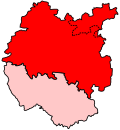Leominster (UK Parliament constituency)
| Leominster | |
|---|---|
| Former County constituency for the House of Commons |
|

Boundary of Leominster in Herefordshire for the 2005 general election.
|
|

Location of Herefordshire within England.
|
|
| County | Herefordshire |
| 1885–2010 | |
| Number of members | One |
| Replaced by | North Herefordshire |
| Created from | Herefordshire and Leominster |
| 1295–1885 | |
| Number of members | 1295–1868: Two 1868–1885: One |
| Type of constituency | Borough constituency |
| Replaced by | Leominster |
Leominster was a parliamentary constituency represented until 1707 in the House of Commons of England, then until 1801 in that of Great Britain, and finally until 2010, when it disappeared in boundary changes, in the Parliament of the United Kingdom.
From 1295 to 1885, Leominster was a parliamentary borough which until 1868 elected two Members of Parliament by the bloc vote system of election. Under the Reform Act 1867 its representation was reduced to one Member, elected by the first past the post system. The parliamentary borough was abolished under the Redistribution of Seats Act 1885, and the name was transferred to a new county constituency.
Following the review by the Boundary Commission for England of parliamentary representation in Herefordshire, no longer connected for such reasons with Worcestershire, two parliamentary constituencies have been allocated to the county. Most of the Leominster seat has been replaced by the North Herefordshire seat, while the remainder of the county is covered by the Hereford and South Herefordshire seat.
1885-1918: The Municipal Borough of Leominster, and the Sessional Divisions of Bredwardine, Bromyard, Kingston, Leominster, Weobley, and Wigmore.
...
Wikipedia
